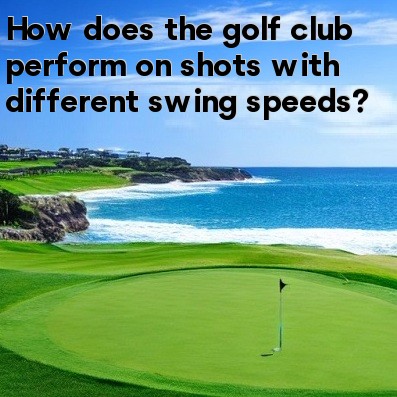
In golf, how does the golf club perform on shots with different swing speeds?
Swing speed plays a crucial role in determining the performance of a golf club. A golfer's swing speed greatly affects the distance, trajectory, and accuracy of their shots. Let's explore how the golf club performs with different swing speeds.
- High Swing Speed: Golfers with a high swing speed generate more power, which translates to greater distance. With a fast swing, the golf club compresses the ball more efficiently, resulting in a higher launch angle and longer shots. Additionally, the golf ball may spin less when struck with a high swing speed, reducing the likelihood of hooks or slices.
- Medium Swing Speed: Golfers with a medium swing speed are often able to maintain good control and accuracy. These players may not achieve the same distance as those with high swing speeds, but they can still generate respectable yardage. The golf club's design and technology can help optimize distance and accuracy for golfers with medium swing speeds.
- Low Swing Speed: Golfers with a low swing speed face challenges in generating distance. However, modern golf club technology has made significant advancements to address this issue. Clubs designed specifically for players with low swing speeds, such as game improvement irons or drivers with larger heads and more forgiving faces, can help maximize distance and increase ball speed off the clubface.
Golf clubs are designed to maximize performance for different swing speeds through various key factors:
- Clubhead Design: Different clubhead designs can influence launch angle, spin rates, and forgiveness. Golf clubs designed for high swing speeds may have smaller, more compact heads for greater control. Conversely, clubs designed for low swing speeds often feature larger clubheads, which increase the club's moment of inertia (MOI) and provide more forgiveness on off-center hits.
- Shaft Flexibility: The flexibility of a golf club's shaft is crucial in optimizing a golfer's swing speed. Stiffer shafts are generally recommended for golfers with high swing speeds, as they offer more control and accuracy. On the other hand, golfers with low swing speeds may benefit from more flexible shafts, as they can help maximize clubhead speed and distance.
- Weight Distribution: Golf clubs with different weight distributions can affect swing dynamics. Clubs designed for high swing speeds often have a forward center of gravity (CG) position, promoting a lower launch angle and reduced spin. Conversely, clubs designed for low swing speeds may have a CG positioned farther back, helping to launch the ball higher for greater carry distance.
Ultimately, finding the right golf club for your swing speed is crucial for optimal performance on the course. It's recommended that golfers get fitted by a professional or consult with knowledgeable staff at golf equipment stores to determine the best club specifications for their swing.
In conclusion, the golf club's performance is greatly influenced by the golfer's swing speed. High swing speeds can result in longer shots and lower spin, while golfers with medium swing speeds can achieve good control and accuracy. Golfers with low swing speeds can benefit from clubs specially designed to maximize distance and forgiveness. By understanding and considering one's swing speed, golfers can select the appropriate golf club to enhance their performance and enjoy the game to the fullest.





